"Stereotypes": A Source of Error in Judging Human Character
Stuart A. Rice
University of Pennsylvania
Dr. Rice has approached from a new angle the subject of judgments of personality. By studying classifications of individuals made from their photographs, he has demonstrated preconceived notions of the physical appearance of members of a certain race, class, occupation, or social group. Further analysis shoos the reasons for these judgments. Dr. Rice has made a contribution of importance to the study of personality types and human relations.
THE extent to which character and intelligence are revealed in human features has been made the subject of various experiments in which photographs of unknown persons have been graded by a number of examiners. Hollingworth compared the average deviation of such judgments with the chance deviation in the case of such graded traits as intelligence, perseverance, kindness, conceit, courage, humor, and deceitfulness.[1] In a similar list of traits, the rankings based on photo-graphs were compared with the judgments upon the same individuals made by persons to whom the latter were known. Correlations between the two sets of estimates were presumed to provide a measure of the reliability of the first set. Pintner,[2] Anderson,[3] and others have employed similar methods, in particular comparing the results of intelligence tests with estimates of intelligence based upon photographs.
On the basis of her own material, Downey[4] says:
When a series of portraits of famous but unrecognized philosophers and good-looking but commonplate pedagogues are arranged in order of merit for intelligence, the commonplace man frequently outranks the great, one.. Condillac, great psychologist, and Comte, great philosopher, fall quite at the end of the group in the average
( 268)
judgment by psychology students. By the use of photographs it should be possible to get some notion of the popular conceptions that bias social judgment.
The last sentence of this excerpt suggests a factor to which insufficient attention appears to have been given in experiments of the 'kind cited. What Lippmann calls "stereotypes" or "pictures in our heads"[5] concerning the supposed appearance of individuals of a certain race, class, occupation, or social group, may determine to which of these groups the original of a photograph is unconsciously referred by the examiner. The sup-posed grouping or type in turn suggests the temperamental or intellectual qualities which are believed to characterize it. It is probable that such stereotypes are largely dependent upon superficial ear-marks as the cut of the hair, the mode of wearing the collar and tie, and other modes of dress.
The experiments described below were designed to show the existence of stereotypes concerning the supposed appearance of persons of various social types, or having defined social functions. These were undertaken originally for purposes of class-room illustration. The participants in various Phases of the experiments were, first, 258 undergraduates of Dartmouth College, in small classes, over a period of two years. Subsequently, the assistance of 31 members of the Norwich Vermont Grange, attending a regular meeting, was procured to provide comparative results.
In an edition of the Boston Herald for December 15, 1924, were found nine portraits of persons represented in the day's news. The reproductions were unusually clear and were uniformly about two by three inches in size. They were placed without identification upon a sheet of paper and numbered from 1 to 9. The individuals pictured were as follows: Edouard Herriot, at that time Premier of Prance; James Duncan, Vice-president of the American Federation of Labor; Leonid Krassin, first Ambassador of the Soviet Government at Paris; Joseph W. McIntosh, Deputy Comptroller of the Currency; Martin H. Glynn, former Governor of New York; Max Agel, arrested as a bootlegger; Charles M. Schwab, of the United States Steel Corporation; Howard Heinz, manufacturer of food products; and Senator George Wharton Pepper, of Pennsylvania. In the first aspect of the experiment, the subjects were informed that the sheet contained the pictures of a bootlegger, a European premier, a bolshevik, a United States Senator, a labor leader, an editor-politician, two manufacturers, and a financier. They were asked to identify these individuals by number. Care was taken that no suggestion be given in the instructions concerning the order of the photographs, and that each examiner make independent selections for each position. Table 1 gives the result of the attempted identifications by 141 students. The numbers are not uniform in each column for the reason that in a" few cases the pictures . were known to the examiners, while in a few others no identifications were attempted.
( 269)
Allowing for the fact that two manufacturers were included among the portraits, the total number of correct identifications on a chance basis would have been approximately 168. The actual number of correct identifications was almost exactly double that number, or 337 out of a possible 1224. On a scale between the expected or chance number and respective status in a number of cases substantially above the chance number. Krassin, McIntosh, and Pepper were below or equal to chance or expectation.
In the case of Krassin, the Soviet Envoy, a wing collar, Van Dyke beard and moustache contribute to an appearance that may be described as distinguished, and which no doubt the maximum possible number of correct identifications, the excess number of correct identifications was 169 out of 1056, or 16 per cent. However, such a measure as this percentage provides would not give comparable results as between different series of portraits.
Interest attaches to the fact that Herriot, Duncan, Glynn, Agel, Schwab and Heinz were related each to his
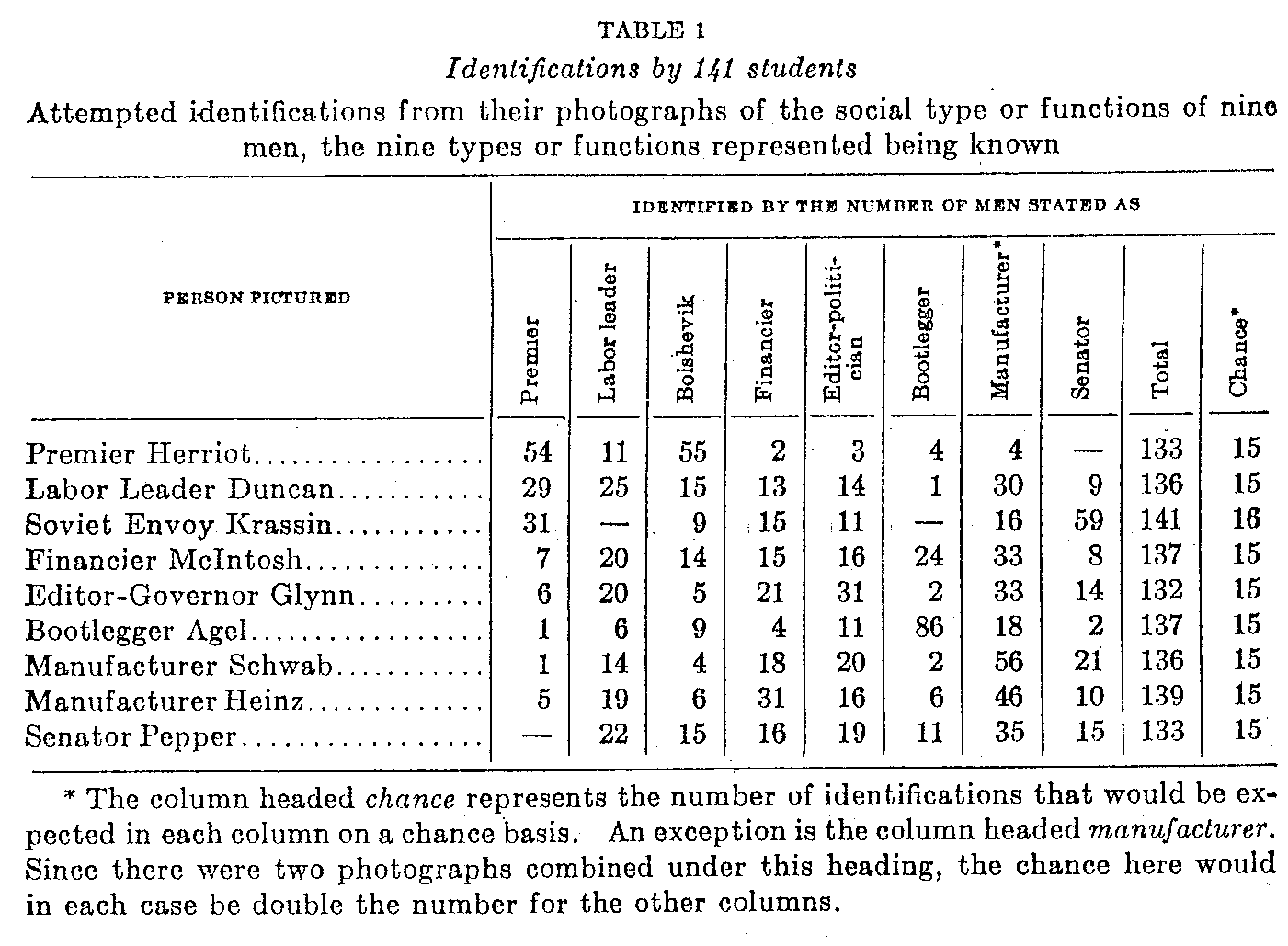
led to 59 identifications as the United States Senator, in comparison with 9 as a bolshevik and none as a labor leader. Senator Pepper received as many or more identifications as labor leader, bolshevik, financier, editor-politician, and manufacturer than he received in his own senatorial capacity. The largest number of correct identifications was made in the case of the alleged bootlegger. This indi-
( 270) -vidual alone among his associates in the gallery, is pictured in out-door costume. He is shown' in a heavy overcoat with up-turned collar, a cap, tortoise-shell glasses and cigar 'gripped firmly between his lips. It is interesting that while Mr. Duncan was identified by 25 men' as the labor leader, he was selected by 29 as the premier, by 30 as a manufacturer, by 15 as a bolshevik and 13 as the financier. It is evident that he did not fit definitely into any pronounced stereotype among those called forth by the characters enumerated.
When a comparison of the preceding data is made with that obtained from the group of grange members and presented in table 2, the correspondence is seen to be fairly close. Among the latter the total number of correct identifications on a chance basis would have been 291/2 out of a possible 219.
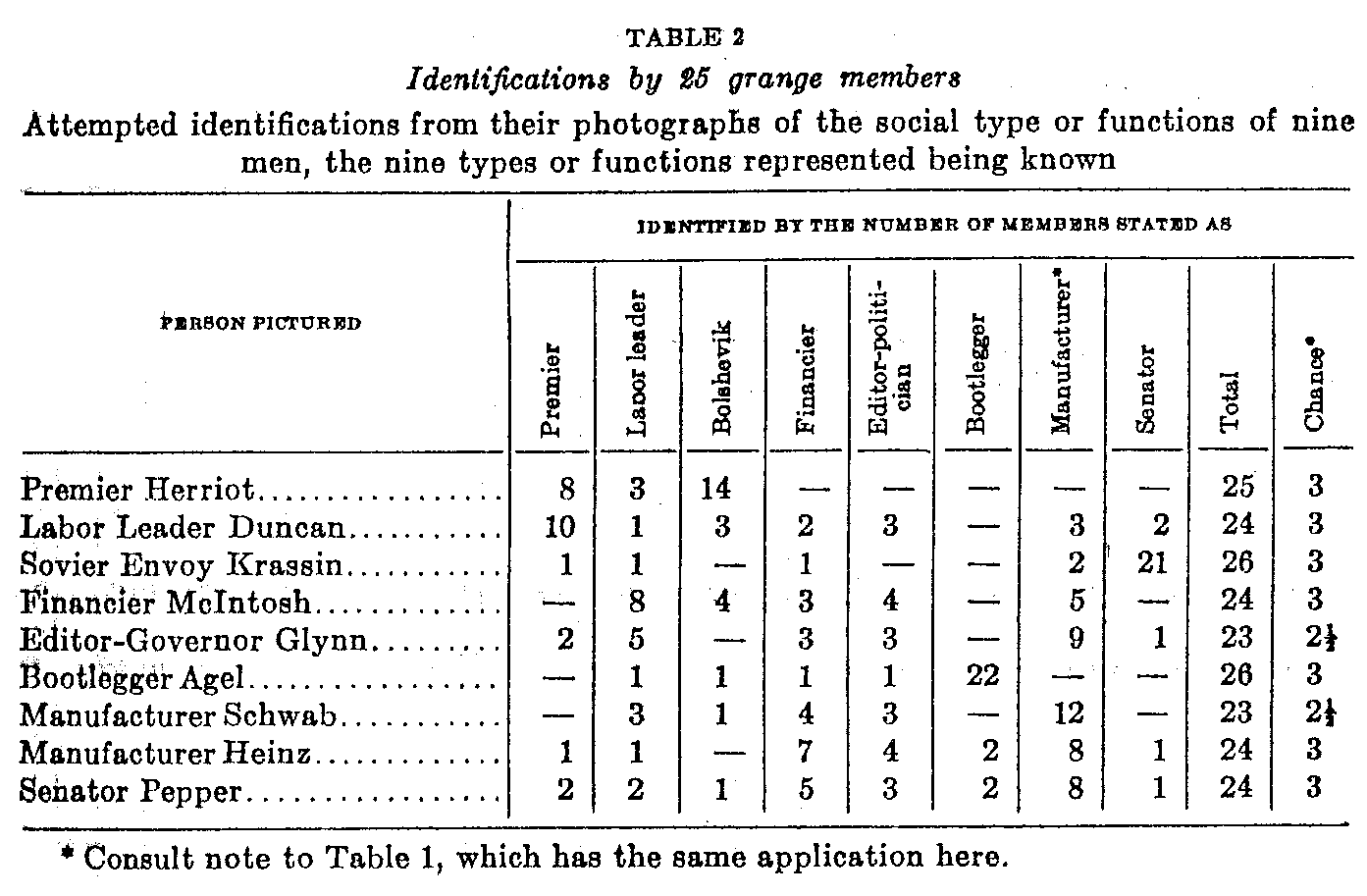
The correct identifications actually number 58, or again almost exactly twice the expectation. Herriot, Agel, Schwab and Heinz, as among the students, were correctly identified in more than the chance number of cases, while the distribution in other respects shows a close parallel, especially in the high proportions of correct identifications of the bootlegger, and incorrect identifications as 'Senator’ of the Bolshevik envoy.
It is evident that some measure of the extent to which opinion has concentrated in the identification of each portrait would be useful. Wherever there is concentration among the identifications, whether these be correct or incorrect, there will be evidence of the existence of a common stereo-type concerning the social designation to which the portrait is assigned.
Such a measure has been found by
( 271) calculating in the case of each photo-graph the total and the relative differences between the numbers of identifications made for each social designation (i.e., under each column in tables 1 and 2) and the corresponding numbers that would be expected on the basis of chance. For example, the chance number of identifications for Premier Herriot in each column of table 1 would be 15. The differences between the chance and the actual numbers of identifications are respectively 39, 4 40, 13, 12, 11, 26 and 15. These total 160. But since the chance number in the case of each portrait is derived from the total number of identifications of that portrait and is a function of the latter, the aggregate number of differences so determined may be related in each case as a numerator to the total number of identifications as a denominator. This fraction, when converted to a decimal figure, will provide a relative index of departure from expectation. This index will serve one of the purposes of a coefficient of variation, for by its use it is possible to compare the relative concentration of opinion concerning each portrait in the two groups providing data.[6]
In table 3, there is shown for each group the total departures from chance expectation, the indexes of departure from expectation, and the rank of the nine portraits according to the latter. It will be noted that a high total departure and a high index within each group, and a high index in either group, denote a relatively high degree of concentration of opinion, i.e., of agreement among the examiners.
When the corresponding indexes shown in table 3 are compared it is observed that in each case those for the grange group are higher. This indicates that within the latter there is a greater concentration of opinion. If the thesis of this article is correct, it indicates that members of the grange are more prone to form their identifications upon the basis of stereotypes than are the students.
The order of rank among the nine portraits in the matter of concentration of opinion is closely similar in the two groups. When correlated by the
( 272) well known Spearman formula the coefficient of correlation, r = 0.84. Herriot ; Krassin and Agel occupy first, second or third position in both groups, though it was only in the case of Agel that the centering of agreement among the examiners took place upon the correct identification..
The appearance of each of these men as portrayed could be' described for one reason or another as striking, in comparison with the others. In the case of each, it is safe to assert, one or more stereotypes, held in common among the judges, were evolved. With each stereotype, moreover, it seems likely that characteristic mental and moral qualities supposed in a similar I stereotyped fashion to accompany it were suggested to the judges, and seen inferentially in the corresponding features.
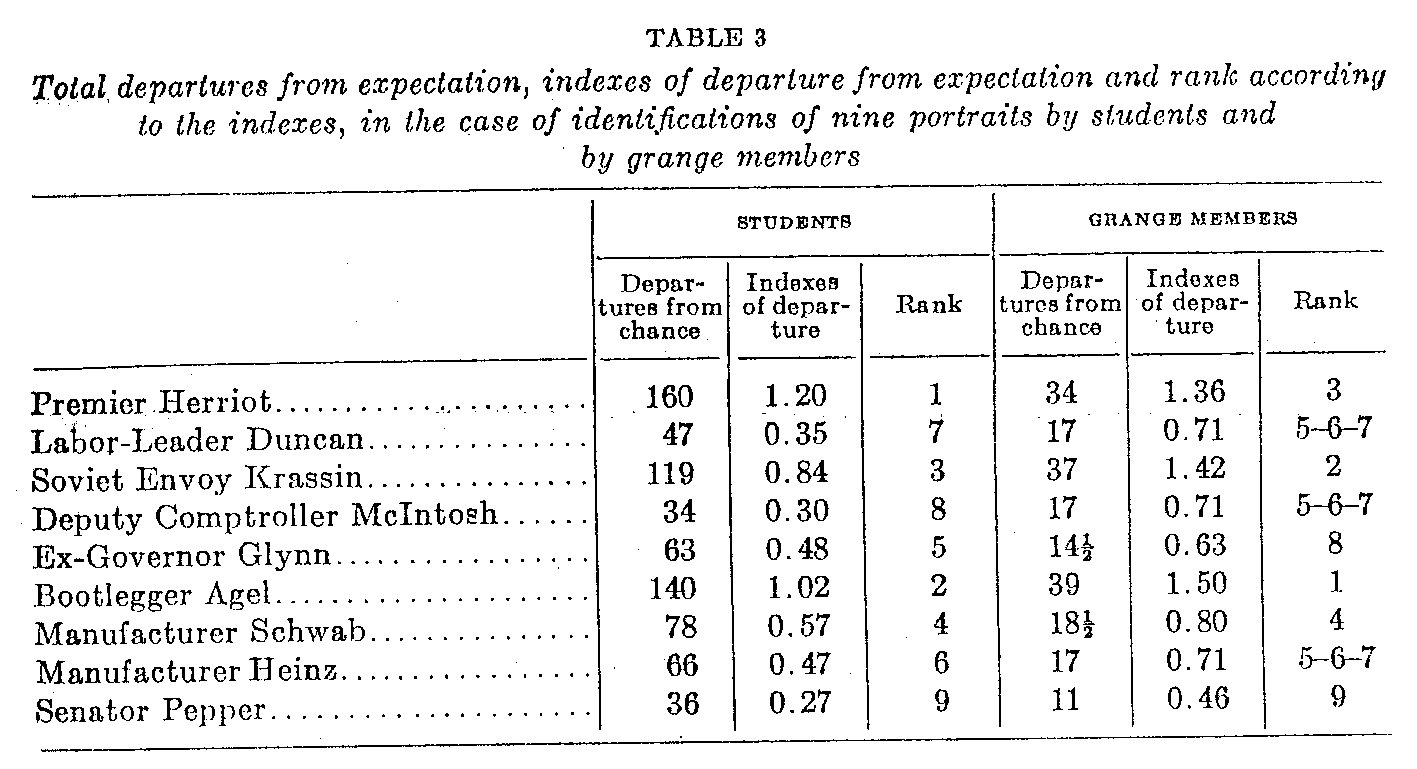
In an effort to check this assumption, a further step in the experiment was taken by securing ratings of the sort obtained by Hollingworth. Students who had not hitherto acted as judges were used as subjects.[7] However, it is probable that interest in the previous experiments had already been aroused outside of the classroom among some of the subjects and that a number had an impression in consequence that there was a catch in the directions given. The same group of grange members as before was employed for comparison, all phases of the experiment being carried through upon a single occasion.
In the case of the students, three groups of judges were used. Each was requested to grade the nine portraits, first according to' intelligence, second, according to craftiness. The latter was defined as that characteristic, the possession of which would lead to the taking of an unfair ad-vantage in a business negotiation.
( 273) The first group of judges, 47 in number, were given no statement concerning the identity of the men portrayed. The second group, 31 in number, were misled by a set of false identifications, conforming so far as possible to the major erroneous identification in the earlier part of the experiment; that is; with an incorrect stereotype. These false identifications were as follows: Herriot as Bolshevik, Duncan as European Premier, Krassin as United States Senator, McIntosh as manufacturer, Glynn as financier, Agel as manufacturer, Schwab as editor-politician, Heinz as labor leader and Pepper as bootlegger. The third group, 39 in number, were shown the portraits accompanied by the real identities.
In the case of the grange members, the group was first asked to grade the nine portraits according to intelligence, without any identifications being given or suggested. After a lapse of time during which
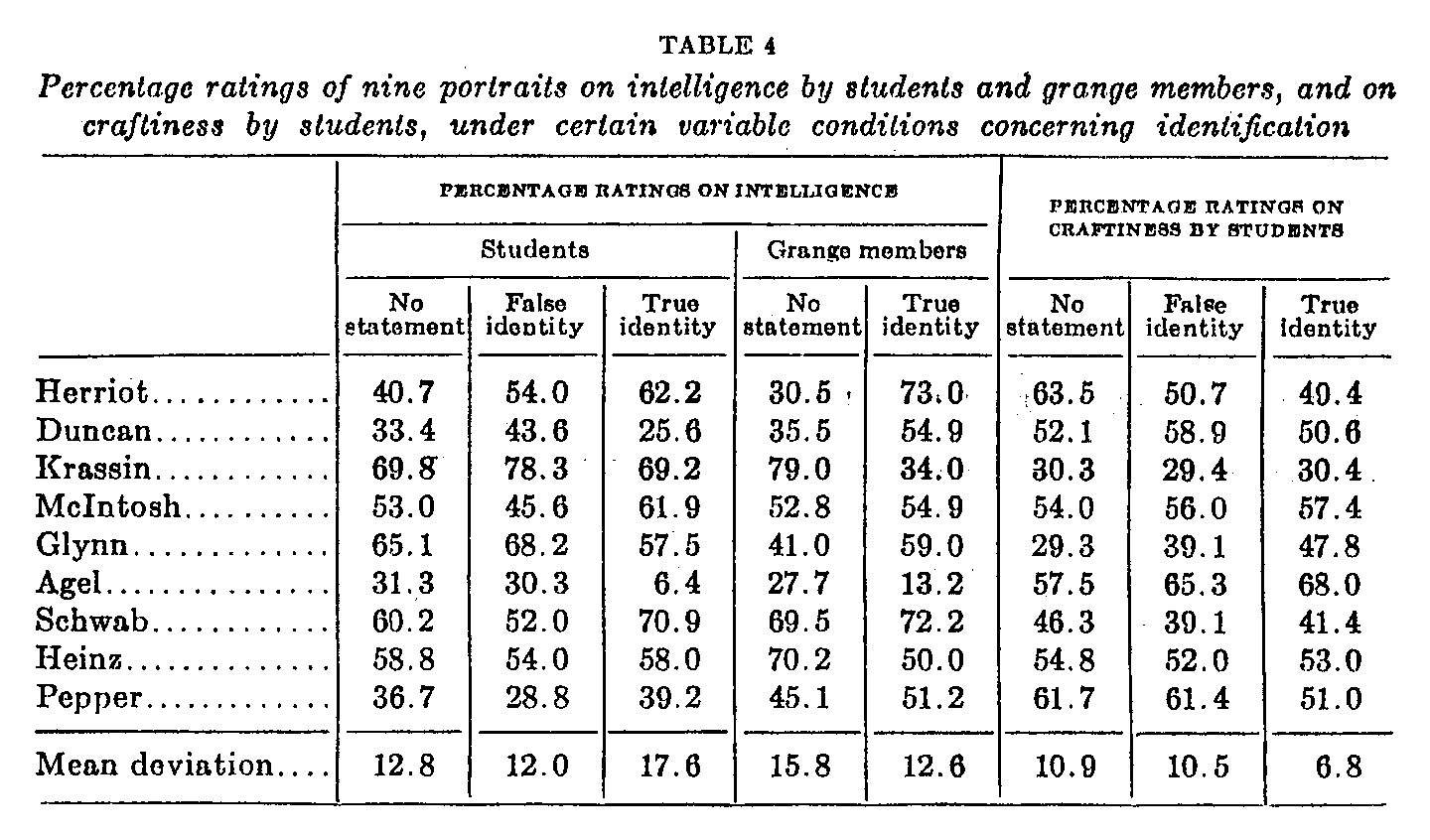
identifications were attempted by the members themselves they were asked to fold their papers in such a way that the first series of grades would be concealed. The correct list of identifications was then placed beside the portraits and they were asked once more to re-grade the portraits in intelligence without reference to their earlier gradings. The circumstances and the time allotted did not permit of gradings upon craftiness, or of gradings upon an erroneous set of identifications. Eighteen papers on which the grading and regrading were both carried through were received.
In aggregating the ratings in each case, an arbitrary system of weighting was employed, in accordance with which the picture rated highest was valued at 8 each time it was placed in this position. The second position in the rating was valued at 7, and so on down to the last or ninth posi-
( 274) -tion, which was valued at 0. The possible aggregate rating, therefore, ranged from 0 in the event that a certain picture was in each case rated ninth in the series, to a figure amounting to the product of eight times the number of ratings given-a figure possible of attainment only in the event that a given picture was in each case rated first in the series. The aggregate rating actually received by this method when related to the maximum, possible rating as a percentage of the latter, affords a basis of comparing the valuation placed upon the various portraits under the various, circumstances indicated.
The changes in percentage ratings on intelligence when the true identities were disclosed, as compared with those made without statement or suggestion concerning identity, are as follows:
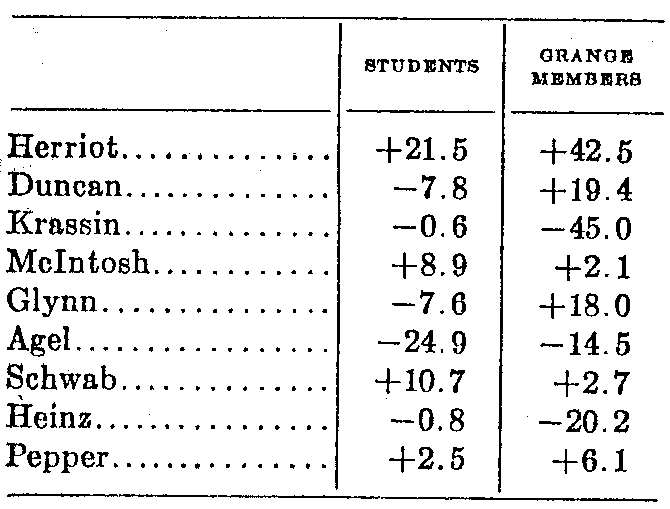
In table 4 these percentage ratings only are presented, both for the students and for the grange `members in the case of intelligence, and for the student alone in the case of craftiness. It should be noted particularly that three groups of individuals are referred to in the case of student rating, while the grange ratings are made in both cases by the same individuals. How-ever, the variable conditions indicated by the column headings "No statement" and "true identity" are as near as possible alike in both cases.
Table 4 and the changes in rating under variable conditions indicated therein seem to indicate that ratings on intelligence and craftiness from photographs are influenced by the assumed or known identity or social type of the individual portrayed, that is, by the stereotype of such a person in the mind of the judge. Disclosure of the true identities of the nine men portrayed led to changes of rating in the same directions among both students and grange members, except in the case of Duncan, labor leader, and Glynn ex-Governor. It seems clear that among these nine individuals those whose positions or names in the business or professional world carry prestige, particularly McIntosh, Schwab and Pepper, tend to improve their ratings in intelligence and (except in the case of McIntosh) to decrease them in craftiness as their identities become known. The loss of Heinz in intelligence rating is only an apparent exception to this, for the mistaken identifications in this case were very largely for positions in the series which carry prestige. That is, no added impression of high social position was given by a disclosure of his identity. On the other hand, the declines in intelligence rating for the bootlegger and the bolshevik are striking, : the former most noticeably among the students and the latter among the grange members.
Comparisons running counter to
( 275) a priori anticipation include that for Krassin, who among the students rates but slightly higher in craftiness when known as a bolshevik than when falsely represented to be a United States Senator. Nor do the data always appear consistent, as when the students rate Duncan higher in craftiness when alleged to be the Premier, while Herriot rates lower in the same characteristic when actually identified as the real holder of this position. But other variable factors of explanation may enter here; more-over it must be remembered that the numbers of judges are small.
Some of the more general conclusions suggested by the preceding data may be summarized:
1. The existence of common stereotypes concerning the appearance of various classes of persons (senators, bootleggers, etc.) is clearly indicated. These led to numerous errors of judgment.
2. The stereotypes found among students and grange members were similar, but there appeared to be a somewhat greater uniformity (concentration of judgment on the basis of a stereotype) among the latter.
3. Estimates of intelligence and craftiness, presumably based upon the features portrayed, are in reality influenced by the supposed identity of the portrait, i.e., by the stereotype of the supposed occupational or social status held in the mind of the examiner.
The implications suggested are both theoretical and practical. The data serve to emphasize the inescapable bias of preconception to which every-one is subject. Stereotypes afford a necessary economy of effort ; in the process of cataloging our environment. We take note of an actual or alleged association, which may be wholly fortuitous, among the attributes of an individual. From this we generalize and assume a constancy of the association. The appearance of another individual presenting a few of the attributes so associated leads us to believe that we recognize in him the other attributes as well.
The process of filling out our actual sense perceptions in this manner takes place in our face-to-face estimates of other people, no less than in the case of estimates made indirectly from photographs. The distorting effect even upon work which is presumed to be scientific may be given a further illuminating illustration: In his study of the criminal, which followed Lombroso in assuming the existence of an anthropological criminal type, Have-lock Ellis presented a series of sketches of criminals made from life by Dr. Vans Clarice, a prison governor. They were alleged to be "by no means very exceptional, "representing "at least10 per cent of the criminals examined."[8]
The widely known Goring report reduced these sketches to a composite portrait, which evidenced features of a highly abnormal appearance.[9] Beside this it placed a composite portrait made from an equal number of photo-
( 276) -graphs selected at random from the official stock of photographs of a prison population. The features in the second case show no appearance of abnormality. The report comments: "An examination of these contrasted outlines shows most strikingly the difference between ‘criminal types,’ as registered by the mechanical precision of a camera, and as viewed by the imagination of an enthusiastic, but uncritical, observer." In other words Dr. Clarke's sketches were biased in a constant direction—the direction of his stereotype of the men before him.
Similarly one is made skeptical of attempts to derive scientific generalizations from biographical data concerning.. historical personages. One enthusiastic writer has referred to biography as "the one ripe and ready field for the study of physiognomy." "A tabulation of the faces and figures of eminent personages should' long ago have suggested itself as desirable, if not indispensable."[10]
It is to be supposed that even con-temporary biographers are fully as subject to stereotypes concerning their heroes as was Dr. Clarke with reference to the prisoners under his charge.
When individuals are in face-to-face contact there is usually an opportunity for the more erroneous stereo-types possessed by either concerning the other to be corrected in the process of becoming acquainted. First impressions are modified by conversation and other expressions of personality. When personality is judged by photographs, or by first uncorrected impressions of appearance, on the other hand, it is inevitable that striking errors will be made. It seems evident that a method of arriving at judgments concerning the character of fellow men or women, sufficiently realistic to serve as a basis for an employment policy, for example, cannot lean heavily upon photographs. The discovery and complete elimination of stereotypes is not wholly possible, but its approximation can probably be attained only as the result of face-to-face inter-stimulation and response.
(Manuscript received February 6, 1926)